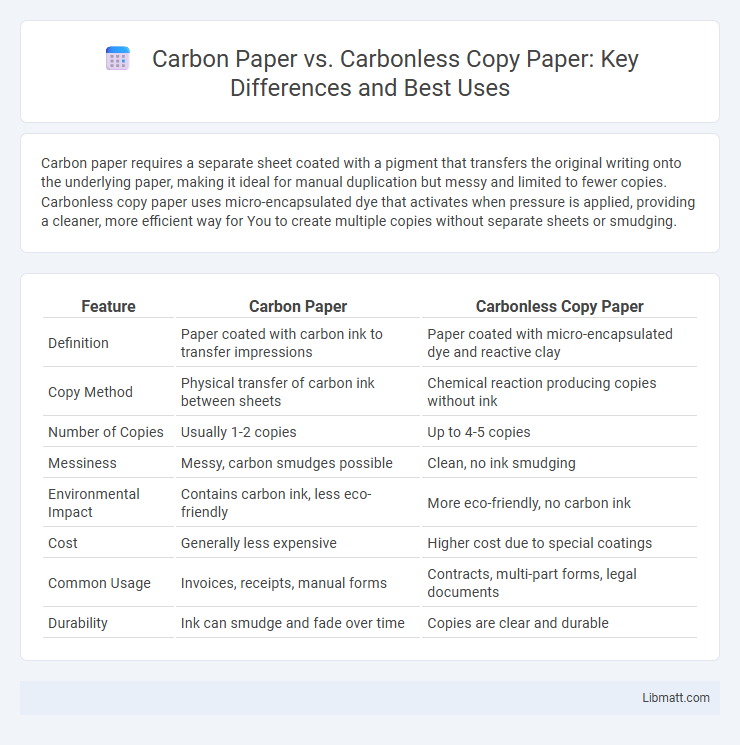Carbon paper requires a separate sheet coated with a pigment that transfers the original writing onto the underlying paper, making it ideal for manual duplication but messy and limited to fewer copies. Carbonless copy paper uses micro-encapsulated dye that activates when pressure is applied, providing a cleaner, more efficient way for You to create multiple copies without separate sheets or smudging.
Table of Comparison
| Feature | Carbon Paper | Carbonless Copy Paper |
|---|---|---|
| Definition | Paper coated with carbon ink to transfer impressions | Paper coated with micro-encapsulated dye and reactive clay |
| Copy Method | Physical transfer of carbon ink between sheets | Chemical reaction producing copies without ink |
| Number of Copies | Usually 1-2 copies | Up to 4-5 copies |
| Messiness | Messy, carbon smudges possible | Clean, no ink smudging |
| Environmental Impact | Contains carbon ink, less eco-friendly | More eco-friendly, no carbon ink |
| Cost | Generally less expensive | Higher cost due to special coatings |
| Common Usage | Invoices, receipts, manual forms | Contracts, multi-part forms, legal documents |
| Durability | Ink can smudge and fade over time | Copies are clear and durable |
Introduction to Carbon Paper and Carbonless Copy Paper
Carbon paper consists of a thin sheet coated with a layer of carbon or another pigment that transfers ink onto the underlying paper when pressure is applied, making it ideal for creating duplicate documents quickly. Carbonless copy paper uses micro-encapsulated dye or ink that reacts chemically when pressure is applied, eliminating the mess and environmental concerns associated with traditional carbon sheets. Understanding the differences between carbon paper and carbonless copy paper helps you choose the right option for efficiently producing multi-part forms or receipts.
How Carbon Paper Works
Carbon paper works by transferring ink from its coated side to a sheet of paper placed beneath it when pressure is applied, typically through writing or typing. The carbon layer contains pigmented ink that smudges onto the bottom paper, creating an immediate copy of your writing or drawing. This traditional method contrasts with carbonless copy paper, which uses micro-encapsulated dye that reacts chemically without the need for a separate ink sheet.
How Carbonless Copy Paper Works
Carbonless copy paper works by using micro-encapsulated dye or ink on the back of the top sheet and a reactive clay coating on the front of the sheet beneath. When pressure is applied by writing or typing, these capsules break and react with the clay, creating a duplicate mark on the following sheet without the need for carbon paper. Your documents become clean and smudge-free while maintaining an easy and efficient copying process.
Key Differences Between Carbon and Carbonless Papers
Carbon paper requires a separate sheet coated with a layer of carbon ink to create duplicates, whereas carbonless copy paper employs micro-encapsulated dye or ink that reacts upon pressure without needing a coated sheet. Carbon paper can leave smudges and requires careful handling, while carbonless paper offers cleaner, dust-free copies that are especially useful for multi-part forms in business transactions. Your choice depends on the necessity for cleaner copies and ease of use, making carbonless paper more efficient for modern documentation.
Advantages of Carbon Paper
Carbon paper offers the advantage of creating multiple copies simultaneously with a simple and reliable transfer method, making it ideal for situations requiring instant duplication without electronic devices. It provides clear, sharp copies due to its direct ink transfer, ensuring legibility and consistent quality on each copy. Carbon paper is also cost-effective, widely available, and compatible with various paper types and thicknesses, enhancing its practicality for manual record-keeping and form completion.
Advantages of Carbonless Copy Paper
Carbonless copy paper offers the advantage of clean, smudge-free duplicates without the need for messy carbon sheets, making it ideal for creating multiple copies effortlessly. Its chemical coating reacts under pressure to transfer data, ensuring clear, legible copies every time while being environmentally friendlier than traditional carbon paper. Your paperwork becomes more efficient and professional with carbonless copy paper, reducing waste and simplifying document handling.
Common Applications and Use Cases
Carbon paper is widely used for creating instant duplicates in manual typewriting, art tracing, and traditional receipt generation, making it ideal for businesses requiring physical copies without electronic devices. Carbonless copy paper suits environments like medical offices, invoices, and order forms where multiple copies are needed without mess or additional materials. Your choice depends on whether you prefer reusable, clean copies or instant, tactile duplicates for specific professional tasks.
Environmental Impact and Sustainability
Carbonless copy paper offers a more environmentally friendly alternative to traditional carbon paper by eliminating the need for separate carbon sheets coated with wax or dye, which can contain harmful chemicals. This type of paper reduces waste and is often recyclable or made from sustainable sources, aligning better with eco-conscious practices. Choosing carbonless copy paper supports Your efforts to minimize environmental impact through reduced chemical use and improved sustainability in document replication.
Cost Comparison and Availability
Carbon paper is generally more affordable and widely available, making it a cost-effective choice for basic duplicate needs. Carbonless copy paper typically costs more due to its advanced chemical coating but offers cleaner and more convenient copies without the mess of carbon smudges. Your decision should consider the balance between initial cost savings and the ease of use depending on your specific duplication requirements.
Choosing the Right Option for Your Needs
Choosing between carbon paper and carbonless copy paper depends on your specific requirements for document duplication and environmental impact. Carbonless copy paper offers a cleaner, easier process without the mess of carbon residues, making it ideal for multi-part forms and eco-friendly offices. Carbon paper, while less convenient, provides a cost-effective option for low-volume copying where clarity and durability of marks are essential.
carbon paper vs carbonless copy paper Infographic

 libmatt.com
libmatt.com